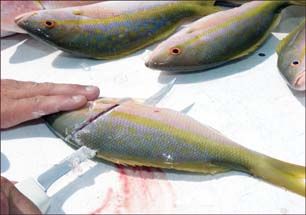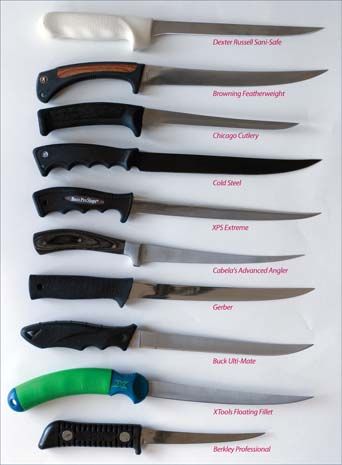
Sashimi at sunset? Snapper sandwiches for lunch? With a seafood smorgasbord blowing bubbles just beneath your keel, a good fillet knife is a must.
Practical Sailor rounded up 10 fillet knives from several marine retailers, with blade lengths ranging from 6 to 9 inches and prices running from a low of $10 to just under $40.
We used each knife to fillet a fish or two and rated its grip, sharpness, strength, and blade flexibility. Strength is determined by the thickness of the blade and its material. Hand in hand with strength is flexibility, again determined by thickness and material as well as blade taper. These are major factors in determining how well a knife fillets a fish.
Getting a clean fillet usually requires the user to follow the fish’s backbone very closely and then, depending on the species, possibly continue by rolling the fillet over and using the knife to remove the skin. Some might simply use their knives to gut a fish and cut off the head and tail. This variety of jobs requires any fillet knife to be a compromise of sorts in both strength and flexibility. We determined winners at a couple of price points by rating how well the knife filleted fish, by examining it for construction details, and checking it for corrosion after a few days.
Berkley Professional
This knife’s hard plastic handle has two screws that when removed allow you to change the blade. The Berkley package included one knife, a plastic sheath, and an extra blade. The knife is sharp and fairly stiff. The blade is a bit short at only 6 inches, but it did cut well. It tapers continuously from the heel to the tip. After using it, we found fish scales stuck in the handle at the heel of the blade. Not good. The blade showed just a spec of rust a few days after cutting fish.
Browning Featherweight
The most expensive knife tested, the Browning, is a beautiful knife that is shipped with a leather sheath. The wide, 9-inch blade is very sharp, fairly stiff, and serrated over 3 inches near the heel. We enjoyed filleting fish with it. The plastic handle has wood inserts, knurling on top, and slots on the bottom to improve your grip. It fit our tester’s hand well and had an adequate finger guard. A few rust specs were evident on the Browning’s blade.
Buck Ulti-Mate
This mid-priced knife ships with a plastic sheath. The 9-inch blade carries most of its width close to the tip before it curves to a point. This makes for a strong and fairly stiff blade. We found it sharp and capable when cutting fish. The plastic handle has indentations for the thumb and first two fingers but lacks a significant finger guard. It also had a few rust specs on the blade.
Cabela’s Advanced Angler
Another one of the good-looking knives, Cabela’s Advanced Angler has a Pakka wood handle riveted to the blade butt section. The smoothly finished Pakka wood is impregnated with resin to protect it from water damage. The 8-inch blade tapers over its full length to form a sharp point. We think it is likely that the tip will eventually break off this knife. The quick taper also makes the knife a bit more flexible than we’d like. We found the knife sharp when cutting and free of any rust a few days following filleting. The blade is marked “stainless” near the heel.
Chicago Cutlery
This knife is packaged with a sheath and small sharpener. The knife fits very loosely into its sheath and could easily fall out. While filleting fish, we found the knife’s 7½-inch blade to be a tad narrow, but quite sharp and flexible. The plastic handle has a slight curve for the hand as well as knurling on the sides to enhance grip. A few rust spots were evident after the knife was used.
Cold Steel
The Cold Steel’s 9-inch blade is stiff, with plenty of backbone for going through ribs or heavier bones, and the blade sides are painted with a black epoxy powder to prevent corrosion. The plastic handle has form-fitted finger grips and knurling on the sides, but lacks a finger guard. Though we really liked this knife for filleting fish, we were disappointed a few days later when we saw the rust that had developed on the cutting edge. Nearly the whole edge had rust stains. Obviously, this knife would need to be sharpened before we could use it again.

Dexter Russell Sani-Safe
This is one of the more expensive knives in our group. This 8-inch knife comes packaged with a plastic scabbard. Its blade remains full width for about three quarters of its length, giving it, as the package says, “perfect blade flex.” We found it sharp and fairly stiff, with plenty of strength for bones, yet flexible enough to remove the skin from fillets. The handle is white plastic with a large finger guard. Some surface rust stains were evident after a few days.
Gerber
This knife is shipped with a plastic sheath containing a built-in sharpener at its base. We found the onboard sharpener gimmicky and hard to use; we’d stick with a sharpening stone. This knife is very sharp and extremely flexible, too flexible for our liking. The blade flexibility can even be felt through the textured plastic handle. No rust stains were noted on the Gerber’s 9-inch blade following use.
XPS Extreme
This is a Bass Pro Shop in-house brand; it’s packaged with a soft sheath and sharpener. The knife’s 9-inch blade is very sharp and too flexible. Like the Gerber, the blade flexibility can be felt even through the handle. The blade on this knife begins to taper about halfway along the blade length, resulting in a very sharp tip. As we mentioned before, these types of very sharp tips are susceptible to easy breakage. The black plastic handle is form-fitted, has knurled sides, a grip-enhanced thumb pad, and an adequate finger guard.
XTools Floating Fillet
This is a rather garish-looking knife, in our view. Its curved blue plastic handle has a bright green soft foam covering the area where your palm and fingers are placed. We didn’t like the handle much; it has too much curve and the foam can slide. The 8-inch blade tapers, beginning about two thirds of the way toward the tip. We found it sharp but too flexible.
Conclusions
Our favorite fillet knives tended to have fairly stiff blades, but still flex enough to skin a fillet. We also like no-nonsense handles with adequate finger guards. Only three knives met the criteria: the Browning Featherweight, the Dexter Russell, and the Chicago Cutlery.
Our top pick is the Dexter Russell. It’s a simple, let’s-get-the-job-done knife, and is slightly less expensive than the Browning. At $20, the Chicago Cutlery is our Budget Buy.
Also With This Article
“Value Guide: Fillet Knives”
Contacts
• Bass Pro Shops, 800/227-7776, www.basspro.com (XTools and XPS Extreme)
• Berkley Fishing, 800/237-5539, www.berkley-fishing.com
• Browning, 800/333-3288, www.browning.com
• Cabela’s, 800/237-4444, www.cabelas.com (Cabela’s, Buck Ulti-Mate)
• Chicago Cutlery, 800/999-3436, www.chicagocutlery.com
• Dexter Russell, 508/765-0201, www.dexter-russell.com
• Gerber, 800/371-7121, www.gerberstore.com



































